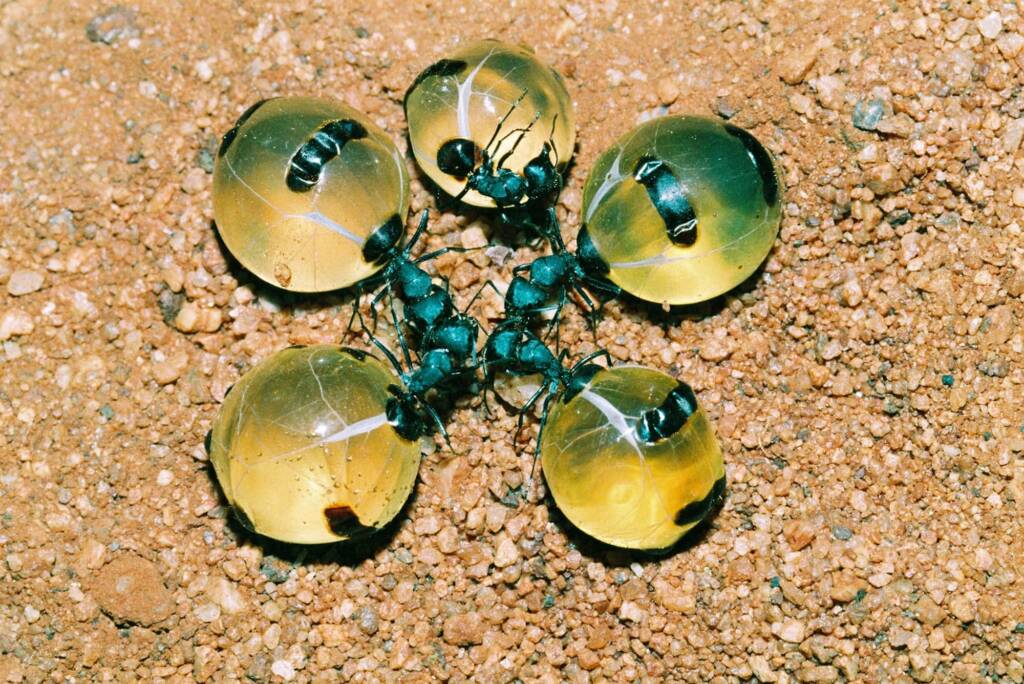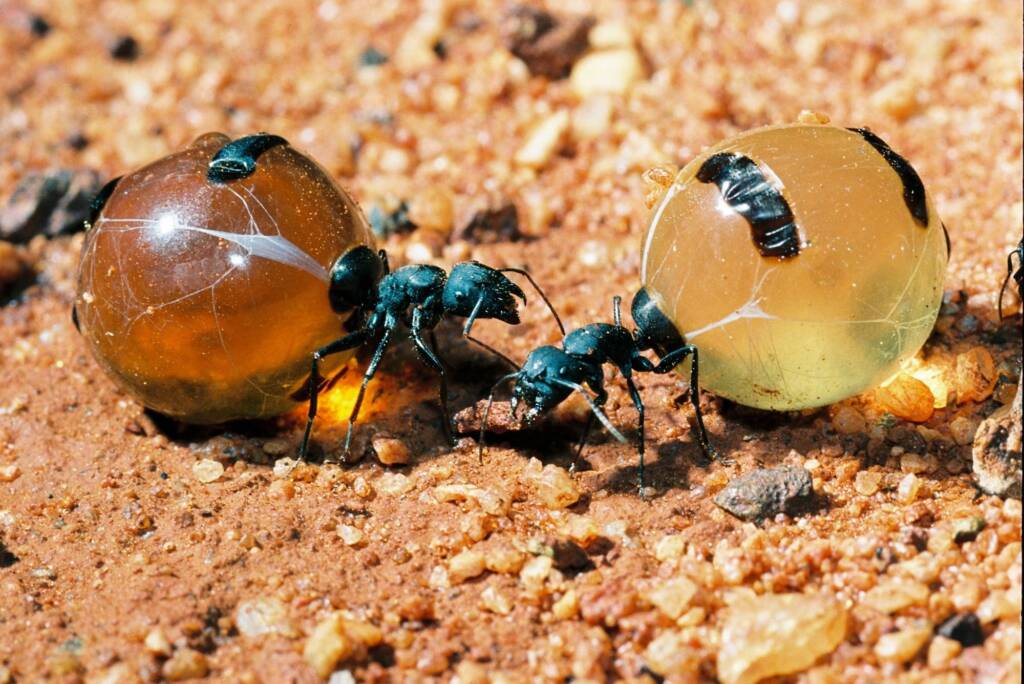FormicidaeAnts Camponotus aurocinctus Camponotus consobrinus (Banded Sugar Ant) Camponotus inflatus (Honey Ant) Dolichoderus doriae (Dolly Ant) Leptomyrmex erythrocephalus (Red-headed Spider Ant) Myrmecia brevinoda (Nocturnal Bull Ant) Myrmecia nigrocincta (Jumping Jack Ant) Myrmecia pilosula (Jack Jumper Ant) Myrmecia pyriformis (Inch Ant) Myrmecia rubripes (Bullant) Notoncus spinisquamis Oecophylla smaragdina (Green Tree Ant) Rhytidoponera aspera Rhytidoponera metallica (Green-head Ant)
Camponotus inflatus, belongs to a group of ants known as Honeypot Ants or Honey Ants, with several species being recorded in Australia.
This particular species, Camponotus inflatus is found throught desert and arid region of the Northern Territory and Western Australia. Camponotus inflatus is closely associated with Mulga (Acacia aneura) bushes/trees, which provides shelter from the high temperatures, as well nectar during flowering and atracting insects, that the ants will prey on. The worker ants feed on the sap-sucking insects (Hemipterans) that live on the the phyllodes (needle-like leaves) or roots of the Mulga bush/tree.

The ant colony lives underground, under or near the Mulga bush. The nest often extends 2 metres below ground, with vertical shafts that lead up to the surface. Honrizontal tunnels run off from the vertical shaft.
The worker ants collect honeydew and nectar, bringing it back underground. This food is fed to a special caste of ants, called repletes, who are the “living honey-pots”. As they are fed, their long slender abdomen swells to the size of a grape. As they cannot walk, they hang from the ceiling of the chambers. When times are tough, the worker ants will stroke the repletes, who then regurgitate the honey, drop by drop, to feed the workers.

Mulga (Acacia aneura) Bush
The Mulga (Acacia aneura), also known as true mulga, is a shrub to small tree that is native the to the arid regions of outback Australia. It can often be the dominant tree in the habitat, giving rise to the term “Mulga Country”.
This bush is an important and valuable resource, providing shelter, tools and food for humans and other creatures.
Tools such as digging sticks, boomerangs, and other wooden tools are made from the mulga. The ash created from burning Mulga twigs, is used by the local Aboriginal people and mixed with Native Tobacco to make a chewing tobacco.
The seeds from the mulga are edible, that once dried and ground, are traditionally made into seed cakes (roasted and ground with water, the edible paste is high in both protein and fat). The pale gum from the branches of Mulga trees can also be eaten, being considered a delicacy.
Another delicacy from the Mulga is the Mulga apple. This is a marble size and shape wasp gall, produced from the branches of the tree. Inside the wasp gall is a small white grub, which is regarded as a sweet treat.
A small insect called the Red Mulga Lerp (Austrotachardia acaciae) also live on the outer branches of Mulga trees. The lerp structure is produced by the larvae of ‘lac’ insects (also known as scale insects), as they feed on the sap of the Mulga. These lerps excrete a sugary gum (known as honey dew), which crystallise around the larvae. This honeydew is sweet, and can be sucked straight off the branch, or the soaked in water for a sweet drink.
It is this honey dew that is collected by the Camponotus inflatus worker ants to take back to their nest.
Another bush food found growing on the branches of Mulga, is the Mistletoe. Kangaroos use the mulga woodlands as a place to shelter, whilst birds such as the Zebra Finches will nest in the branches.
Aboriginal Culture
The honey ant plays an important part in Aboriginal life and culture. As well as bush tucker, they appear in some of their dreaming stories and depicted in artwork by the Aboriginal artists. Check out our section on Honey Ant – Aboriginal Symbols of Fauna and Wildlife.
- Scientific classification
- Kingdom: Animalia
- Phylum: Arthropoda
- Subphylum: Hexapoda
- Class: Insecta
- Informal: Pterygotes
- Order: Hymenoptera
- Superfamily: Vespoidea
- Family: Formicidae
- Subfamily: Formicinae
- Tribe: Camponotini
- Genus: Camponotus
- Species: Camponotus inflatus
Footnote & References
- Honey Ants (Camponotus inflatus), Photographs © Hans Boessum
- Islam MK, Lawag IL, Sostaric T, Ulrich E, Ulrich D, Dewar T, Lim LY, Locher C. Australian Honeypot Ant (Camponotus inflatus) Honey-A Comprehensive Analysis of the Physiochemical Characteristics, Bioactivity, and HPTLC Profile of a Traditional Indigenous Australian Food. Molecules. 2022 Mar 27;27(7):2154. doi: 10.3390/molecules27072154. PMID: 35408553; PMCID: PMC9000567. NLM or the National Institutes of Health, https://www.ncbi.nlm.nih.gov/pmc/articles/PMC9000567/
- Kurku, Tjarulka and Kurkunytjungu, see Kurkunytjungu (Austrotachardia acaciae – Red Mulga Lerp), https://bush-tucker.tripod.com/html/kurku.html
- Red Mulga Lerp, 18 November 2022, by Caragh Heenan, Land for Wildlife / Garden for Wildlife, https://wildlife.lowecol.com.au/blog/red-mulga-lerp/
- Traditional Uses of Australian acacias, by Suzette Searle, World Wide Wattle, http://worldwidewattle.com/infogallery/utilisation/aboriginal.php
FormicidaeAnts Camponotus aurocinctus Camponotus consobrinus (Banded Sugar Ant) Camponotus inflatus (Honey Ant) Dolichoderus doriae (Dolly Ant) Leptomyrmex erythrocephalus (Red-headed Spider Ant) Myrmecia brevinoda (Nocturnal Bull Ant) Myrmecia nigrocincta (Jumping Jack Ant) Myrmecia pilosula (Jack Jumper Ant) Myrmecia pyriformis (Inch Ant) Myrmecia rubripes (Bullant) Notoncus spinisquamis Oecophylla smaragdina (Green Tree Ant) Rhytidoponera aspera Rhytidoponera metallica (Green-head Ant)
InsectsBees Beetles Blattodea Butterflies Coleoptera Cicada Crabronidae Diptera Dragonflies & Damselflies Formicidae Hemiptera Heteroptera (True Bugs) Mango Planthopper Moths Orthoptera Orthopteroid Processionary Caterpillar Stink Bugs, Shield Bugs and Allies Syrphidae Wasps Water Scorpion (Laccotrephes tristis) Witchetty Grub
